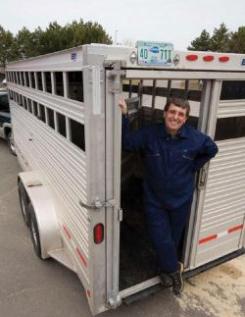
Some people do not take Michael Cockram’s type of research seriously. According to the soft-spoken Englishman, at one time “it was ridiculed in the farming and veterinary press.
Who, after all, needs to know what it takes for a sheep to lose its balance and fall over in a livestock vehicle?” Quite a lot of people, it turns out: from farmer and truck driver and slaughterhouse to processor and consumer.
In Canada, there are relatively few people involved in animal welfare research which uses applied science—such as behaviour and physiology—to indirectly assess mental experiences in animals.
“The role of animal welfare research is to provide a critical and systematic analysis of issues and a framework that can be used to provide the best available answers to practical and ethical questions,” says the new Chair in Animal Welfare at the AVC Sir James Dunn Animal Welfare Centre.
People care about their animals, but also use them for a variety of purposes—from companionship to food—and there are often widely differing views on what constitutes acceptable practice.
But, Cockram says with a wide grin, “I don’t mind a bit of controversy sometimes if it means your academic work doesn’t just remain in a journal.” It is important, he says, to get people to pay attention and change what they do as a result.
Much of his previous work at the University of Edinburgh dealt with determining optimal methods for the transport and pre-slaughter management of farm animals: everything from how much space should be provided during transport to how often the animals should be rested and offered food and water. “Behavioural and physiological measurements of stress, injury, dehydration, fatigue, and the
mobilization of body energy reserves were all used.” The results of those studies led to the development of DVD training materials for livestock drivers.
Animal welfare research, he points out, is a developing subject, one that “can provide information on practical welfare issues which assist policy-makers, animal-users, regulatory authorities, and the general public to make decisions on practices affecting animals.
“The research that I do is different from many aspects of pure science where you go out and discover something,” he says. “It’s all about the appliance of science: finding ways of solving practical questions by trying to pull information from a variety of sources. It’s a steady grind and a progression from one thing to the next.”
One of the first grant applications Cockram wrote when he arrived at AVC in August 2007 was for a study on food animal transport patterns across Canada. “AVC’s expertise in epidemiology provides an excellent opportunity to apply methods developed to study animal health to the field of animal welfare.”
He’s also building on another AVC strength: he’s involved in planning a conference on the welfare implications of management practices affecting the farmed fish and lobster industries.
The Sir James Dunn Animal Welfare Centre is relatively rare, he says, “particularly
being connected with a
veterinary school to look at the veterinary aspects of animal welfare. There’s the potential to apply techniques used previously in livestock to horses, dogs, cats, and wildlife.”
One such project is on dog euthanasia—an initiative by the Canadian Federation of Humane Societies and the Animal Welfare Committee of the Canadian Veterinary Medical Association. It was sparked by the large number of companion animals euthanized because shelters can’t provide homes for them, and, he notes, “the economic situation of a lot of shelters is such that they can’t employ a veterinarian to euthanize the animals.
“It can be difficult to ensure that an animal is killed humanely. And the types of drugs that can be used to euthanize animals are very dependent on whether it’s done by a veterinarian or a non-veterinarian.”
The project will determine current practices across Canada and try to identify best practices, possibly with a view to producing guidelines on euthanasia.
Nor has he abandoned his sheep research. “I have a researcher coming all the way from New Zealand to look at the techniques I’ve utilized in the past to study sheep.”
Cockram has experience working collaboratively in a European environment where the EU regularly sets up trans-national research groups. It’s useful background to have on a small campus where size alone encourages easy access to colleagues. He also wants to collaborate regionally.
“Life is so busy and interesting,” he says, “I hardly have five minutes. But research itself is addictive. Once you start, there is no end to it.”
Cockram came from a village environment in Somerset. “To me, Charlottetown is a big urban area,” he laughs. “Southwest England is an agricultural area but I don’t have a farming background. My father was a builder.” Nevertheless, he found himself interested in biology and the natural environment—still reflected today in his interest in camping and walking.
“Animal welfare is not an off-the-wall topic. It’s a very practical topic that relates very much to traditional animal science, animal husbandry, and veterinary medicine. It’s a global issue and is going to be central to the food-producing industry in Canada. Some of the producers may not know it yet, but it is expanding enormously.”